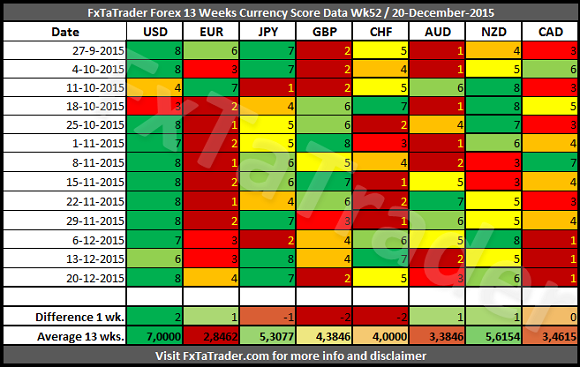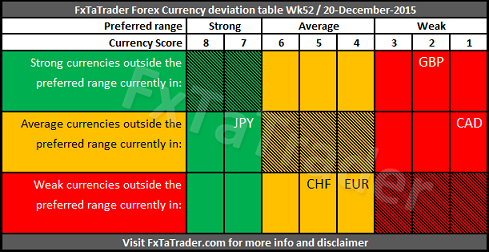The
Currency Score analysis is one of the parameters used for the
Ranking and Rating list which was published earlier this weekend.
Besides this analysis and the corresponding chart I also provide the
Forex ranking and rating list.
It is
recommended to
read the page Currency score explained and Models in practice
for a better
understanding of the article. This article
will provide my
analysis on the 8 major currencies based on the technical
analysis
charts using the MACD and Ichimoku indicator on 4
time frames: the monthly, weekly, daily and 4 hours. The result of the
technical analysis is the 3 screenshots in this article showing the
13 Weeks Currency Score Data, Currency Score and the Currency deviation table.
______________________________________
Last 3 months currency
classification
- Strong: GBP / USD. The preferred range is from 7 to 8.
- Average: CAD / NZD / JPY. The preferred range is from 4 to 6.
- Weak: AUD / CHF / EUR. The preferred range is from 1 to 3.
______________________________________
13 Weeks Currency Score Data
The 13 weeks currency score data and the 13 weeks average is provided here below. This data and the "3 months currency classification" are considered for choosing the preferred range.- At the moment we can see that the CAD has the lowest value in the 13 weeks average. It has been lower than the AUD, which is a weak currency, for the last 6 weeks. The CAD is on the edge of becoming a weak currency and the AUD an average currency.
- Same situation applies to the GBP compared to the NZD. In this case the GBP has been lower than the NZD for 4 weeks when looking at the 13 weeks average.

______________________________________
Currency Score
For analyzing the best pairs to trade the last 3 months currency classification is the first issue. When looking at the most recent score that is used for the coming period we can see in the screenshot below the deviations and we can draw the first set of conclusions. These are given below the screenshot.
______________________________________
- A strong currency can be traded long against all the other currencies except on a pullback(deviation) then it seems best to trade it only against a weak currency.
- A weak currency can be traded short against all the other currencies except on a pullback(deviation) then it seems best to trade it only against a strong currency.
- When an average currency is outside the range(deviation) it is best not to trade it against it's own currencies in the average range and the currencies in the range it is at.
According to the Ranking and Rating list already published this weekend the following pair combinations look interesting:
- USD/CAD with the AUD/JPY
- NZD/CAD with the AUD/USD
- CAD/JPY with the AUD/USD
We will fit each pair if possible in the right group
here below and within each group also add the following abbreviations for the pair combinations:
A. -> SA = Strong Average
B. -> SW = Strong Weak
C. -> AW = Average Weak
Strong currencies
- There is a deviation for the GBP with a score of 2. It should have by preference a score from 7 to 8.
- There is most probably a pullback for this currency
when
looking at the
market as a
whole, the uptrend has lost momentum.
- B. The GBP has a score at the moment of a weak currency and it seems best for trading going long against the weak currencies (SW).
- Possible pair(s) selected from the Ranking and Rating list: none.
- There are no other deviations meaning that the other strong currency (USD) seems best for trading, depending on the opportunities coming around, in the following ways:
- A. going long against the average currencies (SA). Possible pair(s) selected from the Ranking and Rating list: USD/CAD.
- B. going long against the weak currencies (SW). Possible pair(s) selected from the Ranking and Rating list: AUD/USD.
Average currencies
- There is a deviation for the CAD with a score of 1. It should have by preference a score from 4 to 6.
- There is a decrease of momentum for the CAD which is getting weaker.
- A. The currency a score at the moment of a weak currency and it seems best for trading going short against the strong currencies (SA).
- Possible pair(s) selected from the Ranking and Rating list: USD/CAD.
- There is a deviation for the JPY with a score of 7. It should have by preference a score from 4 to 6.
- There is an increase of momentum for the JPY which is getting stronger.
- C. The currency has a score at the moment of a strong currency and it seems best for trading going long against the weak currencies (AW).
- Possible pair(s) selected from the Ranking and Rating list: AUD/JPY and the CAD/JPY.
- There are no other deviations, meaning that the other average currency (NZD) seems best for trading depending on the opportunities coming around, in the following ways:
- A. going short against the strong currencies (SA). Possible pair(s) selected from the Ranking and Rating list: none.
- C. going long against the weak currencies (AW). The pair selected from the Ranking and Rating list is the NZD/CAD.
Weak currencies
- There is a deviation for the CHF and the EUR with a score of resp. 5 and 4. They should have by preference a score from 1 to 3.
- There is most probably a pullback for these currencies when looking at the market as a whole, the downtrend has lost momentum.
- B. Both currencies have at the moment a score of an average currency and it seems best for trading going short against the strong currencies (SW).
- Possible pair(s) selected from the Ranking and Rating list: none.
- There are no other deviations meaning that the other weak currency (AUD) seems best for trading, depending on the opportunities coming around, in the following ways:
- B. going short against the strong currencies (SW). Possible pair(s) selected from the Ranking and Rating list: AUD/USD.
- C. going short against the average currencies (AW). Possible pair(s) selected from the Ranking and Rating list: AUD/JPY.
The following table shows the deviations as mentioned in the description above. All the other currencies are within their classification range. In the next article of this weekend the "Forex Weekly Currency Score Difference" these currencies will be analyzed in more detail to see if there are interesting combinations with other currencies and if there are any overbought/oversold conditions.

______________________________________
- The analyses are complementary where:
- the "Ranking and Rating list" takes strength, direction and volatility into account.
- the "Currency score" looks for the strong trends and pullbacks with a possible disadvantage of being overbought/oversold.
- the "Currency score difference" adds granularity to the "Currency score" by using the score difference for determining potential trends.
- the "Bollinger Band" confirms that a potential trend found is not being overbought/oversold.
- With the "Currency score difference" and the "Bollinger Band" the disadvantage mentioned for the Currency score will be avoided.
When trading according to the FxTaTrader Strategy some rules are in place. For more information see the page on my blog FxTaTrader Strategy. Depending on the opportunities that may come up the decision to trade a currency may become more obvious at that moment. If you would like to use this article then mention the source by providing the URL FxTaTrader.com or the direct link to this article. Good luck in the coming week.
______________________________________


